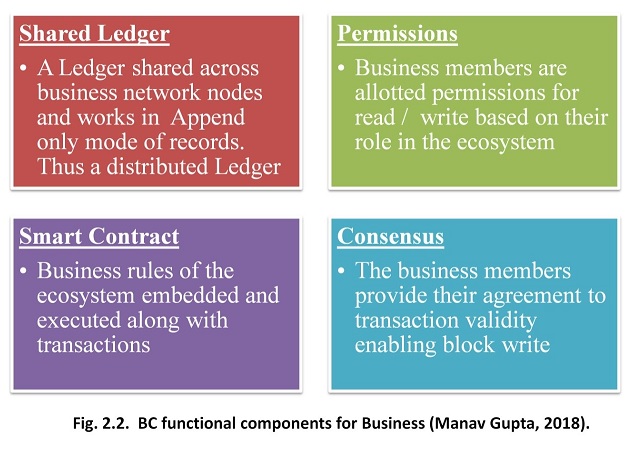The Big Idea
If We can transfer digital currency on a blockchain, why not transfer stocks, bonds and other assets on a blockchain?
Blockchain technology (BCT) offers a plethora of possibilities and benefits for new ways of doing business that disrupts traditional business models. For now, blockchain appears to be the trust machine. It’s inherent characteristics like security, provenance, finality,append-only, consensus-driven, privacy, traceability, time-stamping, etc., have witnessed blockchain’s adoption into emergent areas beyond the initial application area.
BCT enables a business house to extend a new business to its customers by way of Smart Contracts ex: extending to engage in real estate sales or mortgage. This is a bonanza for both the enterprise and the clients. BCT yields value proposition to customers and make many products and solutions affordable to them. Further, Customer relationship is enriched with greater transparency, self-service, automation and above all no middleman. The impact of BCT on business is the simplification in doing business.
Why BCT? Why Not a Database Management System (DBMS)?
While answering the question “why not centralized ledger technology fro business applications?”, Robert Sams of Clearmatics, recalls the three sins of DBMS. These are Sin of Commission, Sin of Omission and Sin of Deletion. The effect of these three on the state of Database is as below:
- Sin of Commission - Forgery of a Transaction
- Sin of Omission - Censorship on a Transaction
- Sin of Deletion - Deletion or reversal of a Transaction
The above three sins, if ever happens in a database, it is a curse. No user would like it. Since Database has Centralized administrator, not to undermine his role, rarely these can happen causing a serious effect. BCT eliminates the above from the possibility.
Table 11.1 Sins Elimination in BCT
| Problem Type | Meaning | How handled in BCT? |
|---|---|---|
| Sin of Commission | Forgery of a Transaction | Cryptography used in BCT addresses the issue along with PKI |
| Sin of Omission | Censorship of a Transaction – preventing it from execution | Case: Private BC -Any participant of the BCT network can broadcast a transaction subject to protocol rules for inclusion in the Blockchain. A rule of this kind rules out the Sin of Omission. Case: Public BC -No Single ownership means no censorship. |
| Sin of Deletion | A transaction that has happened is deleted or reversed without the knowledge of the user | Practically this is not feasible because in a blockchain an entry to be reversed/deleted will have to be a new transaction following the protocol of the network. |
However, it is to be noted that while sin 1 is completely handled in BCT, Sin2 and sin 3 are mutually exclusive and handled by the protocols of the network. The designer of the application has to decide on the trade-off, as demanded by the services that the solution is intended to serve. In fact, one will end up with a decision to go for Public, Permissionless BC or Private, Permissioned BC based on the priority of the characteristics required as in figure 11.1.a and 11.1.b respectively.


You may also recollect and refer our discussions and flowchart in Chapter6 on "When and When Not to use Blockchain?". It adds clarity to your understanding. Also refer to Chapter 2 for Database Vs Blockchain transaction to consolidate the understanding.
By now, It is clear that the idea of Smart Contract over Blockchain Technology enhances business propositions.
Blockchain alleviates Business Friction
Trade brings wealth to the economy. However, market friction is the biggest barrier of trade and wealth creation. This is applicable to global trade too. Regulators and instruments of trust enhance the belief system in a business. Technology help overcome inefficiencies and removes the geographical barrier in doing business. Blockchain Technology has the potential to speed up the pace of business.
Business friction is anything that hinders the exchange of assets by increasing cost or delay. Business friction is very commonly visible in a traditional centralized system of Business. Further, the traditional business practice based on trusted third-party centralized architecture interrupts business with few specific types of market frictions. These are said to be Information friction, Interaction friction and Innovation friction.
Information Friction – happens because of one of the causes:
- Imperfect information (participants get inconsistent or incorrect information for decision making),
- Inaccessible information (abundant information is available but not electronically retrievable) and
- Information risk (vulnerability to hackers and attackers).
Blockchains functional components, specifically the Shared Ledger, Cryptography, Consensus mechanisms, Permissioned network guarantee a consistent state of information and smooth information flow over the network. This, in turn, reduces information friction with reduced time and cost.
Interaction Friction – Interaction friction is caused by the necessity for interactions required in executing a trade. The interactions may be required to resolve geopolitical or legal compulsions. Interaction friction not only increases the cost of the transaction but also the time required to complete the transactions. This friction is directly proportional to the number of interactions required.
Blockchain technology’s P2P architecture and DLT reduces the number of interactions required thereby reducing the interaction friction. Further, in most of the scenarios, the geopolitical and legal rules can be easily incorporated into smart Contract codes, reducing the bureaucratic delays to a large extent.
Innovation Friction – is a state of an organization that it is unable to adapt to market changes rapidly. Innovation friction can also be addressed by BCT provided the organization overcomes inertia and poses a smart approach.
For ease of business, reducing Information friction and easing Interaction and Innovation frictions is necessary.
Blockchain Functional components for Business
IBM leads in enterprise solutions. As usual, leads in Blockchain solutions with Hyperledger Framework. The generic and essential functional components required for any blockchain solution is depicted in figure 11.2. These are Distributed Shared Ledger, Access Control, Smart Contract and an appropriate Consensus mechanism for Blockchain maintenance.

We have discussed in length about these components in the earlier chapters. Here it is a contextual presentation only.
Advantages of Blockchain for Smart Contract
In addition to the characteristics of BC like Security, Tamper-proof, Auditabilty, Transparency the following additional advantages are derived.
Avoiding Double-entry – We had discussed that Double-spend is eliminated by using Blockchain Architecture. Similarly, in the case of Smart Contracts, conflicting or double transactions not added to the blockchain. This is a very important property to enhance the integrity of a contract.
Automation - The Smart Contract validates and adds only verified transactions to the distributed shared ledger. This is ensured by the Smart Contract Code and the BC architecture. Moreover, Smart Contracts are self-executable, self-contained, self-enforceable, and self-verifiable. This is the ultimate automation.
Protection against Attacks – Distributed ledger technology mitigates the damage due to any mischievous attacks, avoiding information loss.
Append-only Ledger - This is a DLT-BC characteristic that enhances the integrity and verifiability of contract execution by stakeholders.
Immutability - Immutability characteristic of Blockchain reduces the risk of fraud and reduces operational errors. This means overall systemic health improvement and efficiency.
Identity – Private, permissioned Blockchain ensures the identity of the participants, validators, and hence, business transparency is enhanced.
Finality – A very important requirement of Smart Contracts is finality. i.e., once a contract is executed, it should be undoubtedly final.

